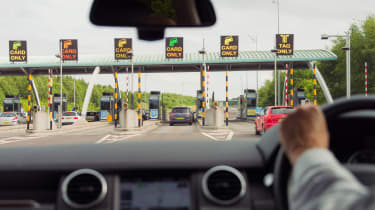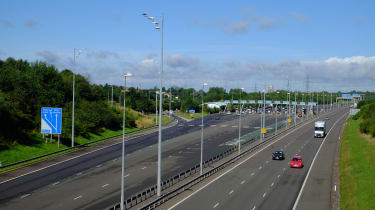The M6 Toll is one of the few UK roads motorists have to pay a fee to drive on. Vehicles using the M6 Toll are charged according to their weight and size, as well as which set of toll booths (also referred to as a toll ‘plaza’) you pass through when joining or leaving the road.
Because the M6 Toll is one of the few toll roads in the UK, it’s understandable that drivers may be unsure on how to use the road, the price structure and how to pay.
If you’ve ever battled traffic around Birmingham on a heavily congested M6 motorway, you’ll understand why the M6 Toll route was conceived to take the weight off the M6. It’s designed to ease congestion in the area where long-haul journeys from London and the South East and from north west cities like Liverpool or Manchester pass through. The plan was for local traffic to continue using the existing M6 motorway, as would traffic heading to other parts of the country such as North Wales or the West Country.
If you’ve never driven on the M6 Toll before, you might have a few questions on how it works, how to pay and how much time it saves. Our handy guide below has all the answers.
How much is the M6 Toll?
The operator of the M6 Toll road has traffic-light controlled toll booths – also referred to as ‘plazas’ – at the north and south ends of the motorway, much like those you’ll find on the autoroutes in France.
The M6 Toll charges for cars and lorries vary according to vehicle size. In the past, motorists travelling off-peak or through the night were charged less than those travelling during the daytime, however, prices changed in October 2023 and now the same fee applies no matter the time of travel.

On the M6 Toll vehicles are classified by type as follows:
M6 Toll price by class
Prices will vary depending upon the size of your vehicle and if you use the entire length of the toll road or leave via one of the junctions. The mainline toll plazas are located at Weeford Park for southbound drivers (between junctions T4 and T3) and Great Wyrley going northbound (between junctions T6 and T7). Here you will pay the full price.
M6 Toll junction plazas provide limited opportunities to leave the M6 Toll. They are situated at junction T3/Langley Mill for Sutton Coldfield and the A38, T4/Weeford Junction for Tamworth, the A38 and A5, T5 for Shenstone and Lichfield, and T6/Burntwood for Cannock and the A5. If you leave the M6 Toll at any of these junctions, you will pay the reduced M6 Toll ‘junction’ price.
|
Mainline price (Full M6 Toll) |
Junction price |
|
|
Class 1: Motorbikes |
£4.30 |
£3.00 |
|
Class 2: Cars |
£8.90 |
£5.80 |
|
Class 3: Cars with trailers |
£12.90 |
£8.70 |
|
Class 4: Vans and Motorhomes |
£15.30 |
£12.30 |
|
Class 5: HGVs and coaches |
£15.90 |
£13.20 |
|
Extra Wide or Heavy Vehicles (depending on vehicle type) |
||
|
Up to 50 tonnes |
Up to £111.30 |
|
|
Up to 150 tonnes |
Up to £302.10 |
|
|
Over 150 tonnes |
Phone customer services on 0330 660 0790 |
|
How do I pay the M6 Toll fee?
Paying for the M6 Toll is fairly straightforward, however, if it is your first time using the toll road, you might be caught off guard. Cash is not accepted at any toll plaza. You have to drive towards any open ‘CARD ONLY’ lane where you can pay by entering your card into the reader or by using contactless payments using a credit, debit or fuel card.
Can I pay the M6 Toll online or open an account?
It is possible to prepay your M6 toll charge online, allowing you to use the Automatic Number Plate Recognition (ANPR) lanes. If you are a frequent user of the M6 Toll, you can get a prepaid electronic toll TAG device, allowing you to use the TAG lane at toll plazas.
The TAG is mounted in the windscreen of your vehicle and allows you to cruise through the TAG lane at the plazas without stopping. Payments are debited automatically from your account, which must have a minimum of £15 in credit for the system to work – TAG users will be charged the standard advertised rates, there is no discount. Receipts are all available and show up on your online account.
How much time does the M6 Toll save?
According to the toll operator, customers report an average time-saving of 25 minutes compared to using the non-toll M6 option. However, when the M6 Toll road time savings were first estimated figures of 45 minutes were quoted, and there’s no doubt the original M6 can still throw up some horrific snarl-ups even though traffic flows have improved.
What happens if I can’t pay the M6 Toll?
If you don’t have a means of payment that’s acceptable when you arrive at an M6 Toll Plaza, you must use the ‘Call For Assistance’ button in your toll lane. An operator will take details, and you will be issued with a Payment Notice that allows you to pay online. Be aware that if you fail to settle a payment notice on time, you can incur a £70 penalty.
Is there a service station on the M6 Toll?
Norton Canes service station is located between junctions T6 and T7 on the M6 Toll, and offers the usual array of brands offering fuel, food and supplies for travellers. You can park free for two hours, and there’s a Days Inn hotel on site for overnight stays.
Do I need to use the M6 Toll?
If you’re heading to London and the south east from north west cities like Liverpool or Manchester (or vice versa) and going via Birmingham, then using the M6 Toll road makes perfect sense.

If you’re heading to or from the South West, you can’t use the M6 Toll because it doesn’t connect to the M5. In particular if you’re heading to the southwest via the M6 you need to take extra care not to end up on the M6 Toll by mistake. If you do, you’ll end up paying the toll and being carried miles off your route as the M6 Toll bears towards the south-east.
Need to sell your car?
Find your best offer from over 5,000+ dealers. It’s that easy.
Local traffic and motorists heading to other parts of the country like the West Country or North Wales will use the old M6. The M6 Toll is arguably not much use to drivers using the M54 on the eastern side of Birmingham either, and they too must rely on the old M6.
Can I avoid using the M6 Toll?
It is possible to avoid using the M6 Toll road and use alternate routes. Avoiding the M6 Toll feels like turning off the original M6 motorway, because two ‘straight ahead’ lanes take you onto the toll road while keeping to the original M6 requires you to ‘turn off’ via the left-hand lane.
Be aware though, drivers heading north or south on the M6 can find themselves directed seamlessly onto the toll road. Too easily, some would say, as the M6 Toll junctions at either end are laid out as though they are the primary through-route of the M6 motorway itself.
If you’re using a sat-nav for directions you’ll often be routed via the toll road automatically because it’s quicker – if no more direct. If you turn off toll roads in your sat-nav system set-up, then you’ll automatically avoid it.
M6 Toll: a brief history
The M6 Toll was designed primarily to provide an easier route for traffic driving past Birmingham when travelling from the north west of the country to London and the south east or in the other direction, easing some of the traffic problems on the heavily congested M6. The preferred route of the M6 Toll was published in 1986, splitting off from the M6 and rejoining it at junctions 3a and 11a – a distance of 27 miles.
In 1989 the government announced the new road was to be privately funded. A consortium called Midland Expressway Ltd won the rights to build and operate the road for a period of 50 years. The M6 Toll took three years to build and was opened in late December of 2003, the perfect Christmas present for drivers who wanted to escape the ordeal of the existing motorway route through Birmingham.
M6 Toll traffic flows have never been as high as originally predicted though, a fact for which the significant M6 Toll charges have been blamed. That’s arguably good news for drivers who don’t mind coughing up, but there are other factors that come into play for drivers contemplating the M6 versus the M6 Toll when route-planning. Depending where you’re headed, it’s not always the most practical option for drivers in the area, so it pays to study the alternatives before setting out.
Frequently Asked Questions
No, only contactless or card payments are accepted at toll booths. You can pay using a credit, debit or fuel card. Contactless payments using a smartphone or smart device are not accepted.
Yes, you can pay online before you travel. Once you have paid your fee and entered your details, you will be able to use the ANPR lanes. Frequent M6 Toll users can also get a toll TAG.
No. The prices and pricing structure of the M6 Toll changed in October 2023, meaning motorists will now pay the same price during weekdays and weekends, day or night.
Customers report an average time-saving of 25 minutes compared to using the non-toll option. But it can be better if the M6 is busy.
A car (Class 2) will pay £8.90 at mainline plazas or £5.80 at junctions. Those towing a trailer (Class 3) will pay £12.90 at mainline booths or £8.70 at junctions.
Yes, Norton Canes service station is located between junctions T6 and T7
What are your tips for using the M6 Toll? Let us know in the comments…

-2.jpg)